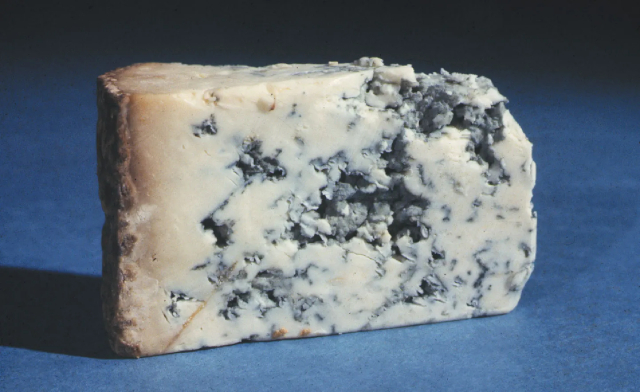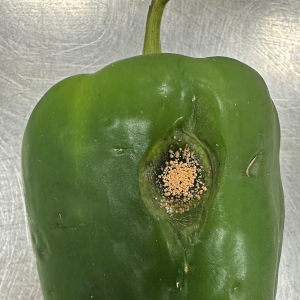We now know it’s okay to eat foods beyond their Best Before dates – as long as they aren’t visibly spoiled. But there are some foods you can eat even if they’re moldy. For some, mold is part of their growth and maturation…
 Bleu cheeses, such as Stilton (above), Roquefort and Gorgonzola, are hard
Bleu cheeses, such as Stilton (above), Roquefort and Gorgonzola, are hard
cheeses that are innoculated with special, traditional, safe yeasts
that produce their colourful marbeling and unique flavours.
But first – What IS mold?
I think we can all recognise mold when we see it. It’s fuzzy, with different kinds boasting different colours and lengths of ‘hair’. It grows on the surface of food and other organic matter when spores from an established colony land on a convivial host.
One thing all molds indicate is, the food you’re looking at is probably spoiled – unsafe to eat. but there are some foods you can salvage afetr they become moldy. And a few that grow mold as part of their natural maturation process.
Foods you can save
Root Veggies
Hard root veggies, such as potatoes, carrots and turnips can still be used of you simply cut off the moldy parts. Be sure to remove a margin around the mold spot. Mold spreads on a host via root tendrils that travel under the surface.
Firm above-ground Fruits and Veggies
Apples, pears and other firm fruits can be salvaged by the same simple method: trim off the mold. Veggies such as sweet and chili peppers can also be salvaged. Squashes and thick-skinned melons may also be saveable.
Hard cheeses
Cheddar is a good example of a popular cheese that can be salvaged if it shows mold. Again, just cur off the moldy part. And be sure to store any part left over after the current use in a fresh, uncontaminated plastic zip bag.
‘Bleu’ cheeses
These coveted ‘strong’ cheese get their flavour and character largely from specific molds that are introduced to them during their production. These molds grow and colonize their host cheeses over a relatively lengthy maturation process.
Hard salami & dry cured ham
Spanish and Italian salamis and dry cured hams – and other dry-cured meats – can easily be salvaged by washing off the surface mold. Mold occurred naturally as these products age and cure. These are very dry products which are very dense inside. The mold rarely penetrates their skins.
Foods you should toss
It’s recommended you toss any of the following foods if they become moldy:
- Cooked processed meats
- Leftover cooked meats
- Cooked casseroles
- Cooked grain and pasta
- Soft cheeses
- Other (soft or liquid) dairy products
- Jams and jellies
- Soft fruits and veggies
- Bread and baked goods
- Peanut butter, nuts and legumes
My take
My Mom and her Mom, and her mother before her, passed down simple rules by which I’ve always handled moldy foods. And it’s no surprise to me that the guidelines they learned – by trial and error, and tradition – closely parallel those quoted above. If anything, my old, reliable family rules re.- mold are even more cautious than those recommended by the US FDA.
Nevertheless, it appears many folks today – especially the under 40s – didn’t get the message from their elders. And I felt it was important to create this post – for them and those they feed.
~ Maggie J.

